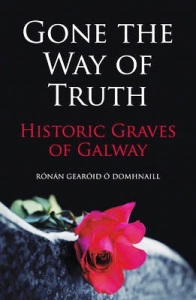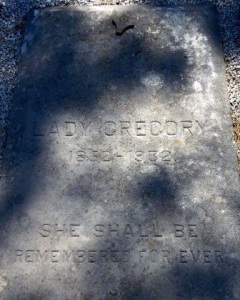Check out more posts from Ruairí on his blogspot at:
https://bunosc.wordpress.com/2016/07/13/
The Great Leveller
Rónán Gearóid Ó Domhnaill, whose mother’s family hail from Dunmore, is something of a polymath. He has great fluency in many aspects of Irish and German language and literature after many years in Europe. He works now as a secondary teacher in Dublin, from where he blogs as An Múinteoir Fánach; writing regularly on diverse aspects of history and folklore. He has published a number of books already; a collection of Irish legends in German, and more-recently Fadó: Tales of lesser known Irish history (2013) which covers intriguing and forgotten stories from around the country; body snatchers, priest catchers and female pirates.
His latest book Gone the Way of Truth: Historic graves of Galway is a return to his roots. The book is not an exhaustive list of all Galway’s graveyards, but rather a romp through some of the county’s most interesting burial sites and a look at some lesser-known people who are buried in them. The book covers Galway city and is thereafter divided four ways, to give a wide insight into the county’s graveyards; north, south, east and west. A concluding chapter covers Galway people buried outside their native county. In terms of north Galway, Ó Domhnaill returned to give a great insight into the ‘old’ Dunmore graveyard. He also spends some time discussing the celebrated Clonberne mausoleum and Temple Jarlath. The author’s extensive research can be seen in a knack for concentrating on those aspects of Galway funerary practices; inscriptions, images and other unusual features that have not received attention in previous surveys. In doing this he manages to bring to life long-forgotten and more recent stories and people in a way that is very human; the carving from the Temple Jarlath monument of a man holding his wife’s hand while she is dying is especially poignant. He is not afraid to tackle tricky topics either, makes extensive mention of the many ‘cillíní’ throughout the county and reminds his readers of their complex post-Reformation origins, that belie their having been simply a place for the unbaptised. He handles the recent ‘Tuam Babies’ story with tact and wisdom.
His extensive coverage of the Bohermore Cemetery in Galway is very valuable and makes it clear that it could well be described as Galway’s version of Glasnevin. If there is ever any doubt that death is the great leveller; of rich or poor, young or old, Catholic or Protestant, lord or tenant, it can be seen in Bohermore. The city’s original burial site at Fort Hill was overcrowded by the post-Famine era and so the city chose Bohermore as its new site in the early 1870s. The site is on an impressive height overlooking the city. It contains two mortuary chapels; Protestant and Catholic, Here, many of the revivalists and rebels currently being commemorated were laid to rest; Tomás Ó Máille, Pádhraic Ó Conaire and Micheál Breathnach, along with Galwegians who fell in the First World War. Here too lie Lady Gregory, Walter Macken, George MacBeth, and even William ‘Lord Haw Haw’ Joyce. Readable and richly-illustrated, Rónán Ó Domhnaill’s is a great guide to the work of the ‘great leveller’ in County Galway.


No comments:
Post a Comment